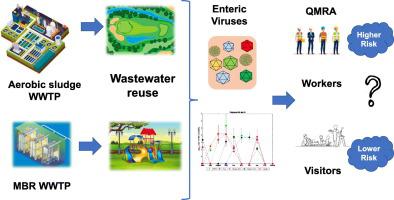Science of the Total Environment ( IF 8.2 ) Pub Date : 2021-02-25 , DOI: 10.1016/j.scitotenv.2021.146039 Andri Taruna Rachmadi , Zubair M. Azizkhan , Pei-Ying Hong

|
Reclaimed water is an alternative water resource to mitigate water scarcity. To promote safe reuse, this paper aims to monitor the enteric virus concentration in the reclaimed water generated by two sewage treatment plants (STP) with different multibarrier technologies, and to assess if stringent treatment extent is required in a low-resource setting to achieve minimal viral risks arising from non-potable reuse. Through a 9-month surveillance, it was observed that a higher diversity and abundance of enteric DNA and RNA viruses were detected in treated wastewater generated from conventional activated sludge (i.e., site B) compared to that from membrane bioreactor-based STP (i.e., site A). To exemplify, enteric RNA viruses were detected in up to 1.13, 4.1, 4.9, 4.5, and 4.5 log10 copies/L for Aichi virus (AiV), rotavirus (RV), norovirus GI and GII (NoV GII, GII) respectively, at site B. For enteric DNA virus, up to 4.3 and 5.35 log10 copies/L of adenovirus (AdV) and polyoma BK virus (BKV) were also found in site B. This is in contrast to the absence of AiV, RV and NoV detected in samples from site A. However, when translated to risks outcome from NoV GII, it was noted that recreational users at both sites A and B are exposed to acceptable disease burden (<10−4 DALYpppy). Occupational workers at site B faced burden risk of 2.01 × 10−4 to 3.85 × 10−4 DALYpppy, which is slightly higher than the acceptable 10−4 DALYpppy but such level of risks can be reduced by minimizing exposure frequency and/or adoption of best management practices. Findings from this study suggests that additional implementation of treatment barriers that incur higher capital investment or energy costs in low resource countries may not be mandatory to mitigate risks arising from enteric viruses for non-potable reuse purposes studied here.
中文翻译:

具有不同多重屏障策略的处理厂再生水中的肠病毒:在处理程度和风险方面进行权衡评估
再生水是缓解水资源短缺的替代水资源。为了促进安全再利用,本文旨在监测由具有不同多屏障技术的两个污水处理厂(STP)产生的再生水中的肠道病毒浓度,并评估在低资源环境下是否需要严格的处理范围以实现最小限度的使用非饮用水重复使用产生的病毒性风险。通过9个月的监测,观察到与基于膜生物反应器的STP(即,网站A)。举例来说,肠溶性RNA病毒的检出率最高为1.13、4.1、4.9、4.5和4.5 log 10在站点B处分别为爱知病毒(AiV),轮状病毒(RV),诺如病毒GI和GII(NoV GII,GII)的拷贝数/升。对于肠道DNA病毒,腺病毒(AdV)最多可达4.3和5.35 log 10拷贝/ L )和B区也发现了多瘤BK病毒(BKV)。这与A区样品中未检测到AiV,RV和NoV形成鲜明对比。地点A和地点B的娱乐使用者都承受了可接受的疾病负担(<10 -4 DALY pppy)。地点B的职业工人面临的负担风险为2.01×10 -4至3.85×10 -4 DALY pppy,略高于可接受的10 -4 DALY pppy但是可以通过最小化暴露频率和/或采用最佳管理实践来降低此类风险。这项研究的结果表明,在资源贫乏的国家或地区实施其他实施治疗措施的措施可能会增加资本投资或能源成本,这对于减轻肠病毒引起的用于非食用再利用目的的风险可能不是强制性的。











































 京公网安备 11010802027423号
京公网安备 11010802027423号